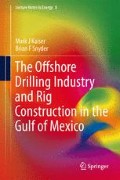Abstract
Jackup hulls provide the buoyancy to be towed to site, and once on location, the legs support the deck weight, which transfers the equipment and drilling rig loads into the seafloor. As drilling progressed into deeper and more challenging environments, rigs evolved based upon the experience of the builder and the demands of the market. In this chapter, we discuss the designs used in jackup construction and the tradeoffs between technical and economic factors. We summarize the design process and discuss the major design factors, highlighting the decisions made at the conceptual and preliminary stages. A discussion of the most popular jackup designs concludes the chapter.
Access this chapter
Tax calculation will be finalised at checkout
Purchases are for personal use only
Notes
- 1.
Other elevating vessels, including those used in offshore construction, offshore wind, and smaller workover rigs, may have four or more legs.
- 2.
A Swiss-cheesed seabed is an area in which jackup rigs have previously worked. In these areas, depressions in the seabed left by earlier rigs can constrain the areas where a rig may be positioned.
References
Blankestijn EP, Mommaas CJ, de Bruijn R (2003) The MSC XY cantilever. Paper presented at the 9th International Conference on Jack-up Platform Design, Construction and Operation, City University, London, 23–24 Sept 2003
Boswell LF, D’Mello CA (1990) The jack-up drilling platform: design construction and operation. Elsevier Applied Science, London, 290 pp
Covellone TC, Thorson JA (1985) Construction and certification of a U.S. flag jackup for Norwegian waters. Paper presented at the SPE/IADC Drilling Conference, New Orleans, 5–8 Mar 1985. SPE/IADC 13424
Eyers DJ (2007) Ship construction. Elsevier, London, 365 pp
Geiger PR (2004) Offshore drilling and production vessels. In: Lamb T (ed) Ship design and construction. Society of Naval Architects and Marine Engineers, Jersey City, pp 1–51
Howe RJ (1966) The evolution of offshore mobile drilling units. Paper presented at the Southern District API Division of Production Meeting, Houston, 5 March 1966. API 66–120
Howe RJ (1986) Evolution of offshore drilling and production technology. Paper presented at the Offshore Technology Conference, Houston, 5–8 May 1986. OTC 5354
Kaiser MJ (2007) World offshore energy loss statistics. Energy Policy 35(6):3496–3525
Kellezi L, Kudsk G, Hofstede H (2008) Jackup foundation design applying 3D FE structure-soil interaction modeling. Proceedings of the BGA International Conference on Foundations, Dundee, 24–27 June 2008
LeTourneau Technologies (2010) Offshore drilling rig construction report. http://www.letourneau-inc.com/offshore/resources/docs/construction_report.pdf. Accessed 10 May 2011
Macy RH (1966) Mobile drilling platforms. J Petrol Technol 18:1069–1081
Mommaas CJ, Blankestijn EP (1984) Development and design of two series of jackups for hostile waters. Paper presented at the 5th Offshore South East Asia Conference, Singapore, 21–24 Feb 1984. SPE 12406
Rammohan V (2005) Structural design of jack up rig platforms. In: Chakrabarti S (ed) Handbook of offshore engineering. Elsevier B.V, Amsterdam, pp 401–413
RigLogix (2011) RigLogix: upstream intelligence system. www.riglogix.com. Accessed 10 May 2011
Vazquez J, Michel R, Alford J, Quah M, Foo KS (2005) Jackup units: a technical primer for the offshore industry professional. http://www.bbengr.com/jack_up_primer.pdf. Accessed 10 May 2011
Young AG, House HF, Turner RD, Helfrich SC (1981) Foundation performance of mat supported jackup rigs in soft clay. Paper presented at the Offshore Technology Conference, Houston, 4–7 1981. OTC 4143-MS
Author information
Authors and Affiliations
Rights and permissions
Copyright information
© 2013 Springer-Verlag London
About this chapter
Cite this chapter
Kaiser, M.J., Snyder, B.F. (2013). Jackup Design Primer. In: The Offshore Drilling Industry and Rig Construction in the Gulf of Mexico. Lecture Notes in Energy, vol 8. Springer, London. https://doi.org/10.1007/978-1-4471-5152-4_10
Download citation
DOI: https://doi.org/10.1007/978-1-4471-5152-4_10
Published:
Publisher Name: Springer, London
Print ISBN: 978-1-4471-5151-7
Online ISBN: 978-1-4471-5152-4
eBook Packages: EnergyEnergy (R0)

